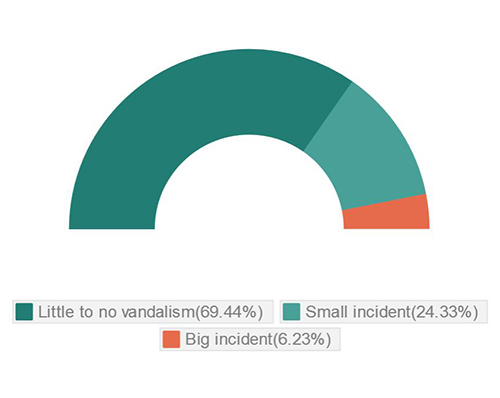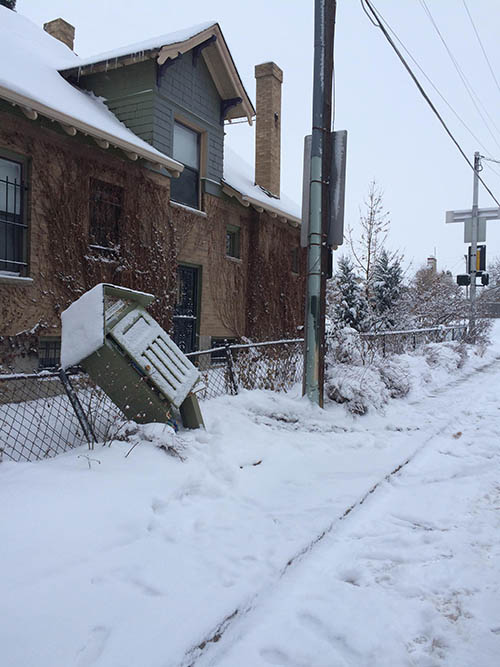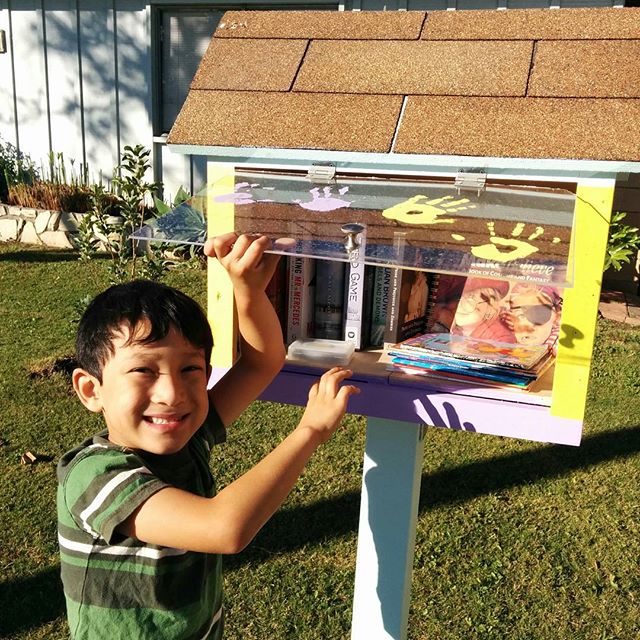In 2010, I discovered a Little Free Library. I fought an overwhelming, joyful urge to sprint up to this tiny box of books and hug it. (I later lost the fight and I actually did hug that Little Library).
But I couldn’t help but wonder: wouldn’t people vandalize them? How many times have you seen graffiti on buildings, houses covered in toilet paper, or other general mischief done to public or private property?
Wouldn’t the same thing, or worse, happen to Little Libraries? Well, for the most part, no.
I conducted an informal survey in the private stewards Facebook group a few weeks ago, asking the stewards to answer a few questions about Library vandalism. Here was my survey.
Which of the following best describes your situation:
- I’ve had very few to no incidents of vandalism
- I’ve had a small incident of vandalism (e.g. books damaged, guest book stolen)
- I’ve had a big incident of vandalism (e.g. Library destroyed or stolen, all of the books repeatedly stolen)
Now, let me mention here that this survey was an informal social media survey. (I suspect my college statistics professor would have a few choice words for me if he saw it!) I’d bet that some stewards put themselves in more than one category; I also think that several survey participants had pretty “young” Libraries
Common sense (and several long-term stewards) tells me that the longer a Little Library exists, the higher the chance there is that some kind of vandalism will happen to it.

But, my goal was to get a rough idea of how many Little Free Library stewards were dealing with vandalism. The results surprised me.
Out of 337 respondents, 70% reported very few to no incidents of vandalism. 24% reported a small incident of vandalism, and just 6% reported a big incident of vandalism.
That means that 94% of the stewards who took the survey reported small problems, or no problems at all. Let’s all do a little happy dance for that!
Still, that 6% of stewards (that’s 21 people!) that reported a big incident of vandalism perplexes me. Why would anyone vandalize a Little Free Library?
I set out to shed some light on the culprits behind Little Free Library vandalism. I talked to several stewards who had dealt with vandalism, and each one actually discovered who had committed the crime.
As it turns out, when someone damages a Library, it’s rarely because they hate it, and think that no one should have free access to books. It’s more complicated than that.
Build a Sense of Shared Ownership
Sage Holbein was one of the first people to ever put a Little Free Library in her front yard. She lives in inner-city Minneapolis, in a neighborhood with a lot of low-income housing and transient residents. Sage was worried about vandalism at first, and she was right to be worried; her Library did get vandalized. Several times.

“In my Library’s second year, there was a group of five or six kids, all about nine years old, walking past the Library. As I watched, one little boy smacked the heel of his hand against the Library, cracking the front window. One girl in the group yelled at him, and then they all ran. Later, that little girl came and knocked on my door. She told me, ‘That little boy doesn’t live here. He’s visiting and he broke the window. We told him that he hurt all of us, and we’re sorry he did that.’”
“There was another issue with an adult living in an apartment building just down the road. I noticed a number of times that the entire contents of the Library would disappear. I had no idea who was doing it, until a neighbor came by and told me that one man in particular who lived down the road would come, take all the books, and try to sell them. This neighbor had talked to the man, explained how the Library worked, and asked him to stop. And, he stopped. Just like that.”
Sage’s experience is a great example of why many Little Libraries get vandalized. In one case, you have a kid blowing off some steam; in another, it’s an adult who wanted to make a little extra money and didn’t really understand how the Library worked. In both cases, fellow neighbors took the initiative and asked the culprits to stop.
“I think it needs to come from the peers,” Sage said. “What I find in this neighborhood is that each person takes care of the Library, and it works better that way.”
“Sometimes, when I read stories about new Libraries, it sounds very ownership-related. But you know, this is stewardship; you don’t own it. Even if you pay for it, or build it, or whatever. You need to learn to let go. If everyone feels invested in the Library, feels ownership of it, they’re much more likely to look out for it, guard it, and care for it.”
Bad Luck Plays a Role
Shortly after her Little Free Library’s second birthday, steward Eleanor Carroll came outside to find several books from her Library thrown into the neighbor’s garden. It had rained overnight, so the books were now sopping wet and useless. Now, why would anyone do that?
Eleanor reported, “Well, our neighbor, after having a fight with his partner, decided to vent his anger by taking some books out of our Library and throwing them into the next door neighbor’s garden. Unfortunately the books got soaking wet, but I’m glad that I know what happened; it wasn’t some mindless act of vandalism targeted at us!”
A Target for No Reason
In perhaps one of the most disgusting acts of vandalism to-date, steward Nancy Bartell came out to her Library a few months ago to find out that someone had . . . ahem . . . defecated inside a book, and put it in her Library. Well, Nancy caught the culprits on video and yes, it was teenage boys.
Gross? Definitely. But was this a targeted act of hatred towards Nancy or her Library? No. The Library was just a convenient outlet for the act.
Just a few weeks ago steward Sue Torf discovered that her Library, installed along a popular hiking trail in her area, had been completely destroyed. Actually, it had been blown up, and Sue had proof. The two teenage boys who did it filmed themselves and posted the video publicly on Instagram.
After watching that video, you might be thinking, but why? What a waste! Well, because teenagers.
I don’t think they blew up Sue’s Library because they hated it or because they hated books; I think they blew it up because they could; because they thought it would be funny or cool.
Sage Holbein had it right. Even if you built or bought or installed the Library, remember that it’s a community resource, and that you can’t control other people’s behavior.
The Good Outweighs the Bad
The thing to remember when a Little Free Library gets vandalized is that the community gets a chance to respond to the incident. In most cases, there is an immediate outpouring of support and goodwill from friends, neighbors and people who just want to help.

Take Sue Torf’s blown up Library, for example.
Sue shared, “I must admit this whole experience has been interesting. I was heartbroken when the Library was blown up, but the outpouring of support from our local community has been amazing. I posted a photo of the destruction on Nextdoor.com, and from there, our community took it upon themselves to investigate. That’s how we found the Instagram video.”
Guess what happened after that? An anonymous citizen went and repaired Sue’s Library, no questions asked. It’s back up and running already.
Steward Carol Campbell has a Library in what she describes as an inner-city, high-poverty neighborhood. Her Library has been vandalized several times, and it was completely destroyed at one point. A drunk driver crashed into the fence where her Library was installed, and smashed the Library (and fence) to pieces.
Carol could’ve given up, but she didn’t.
“I’ve had books from the Library tossed into the street, or the entire Library’s contents cleared out, repeatedly…but I won’t let it discourage me. My Library is in an inner-city neighborhood, and of course Libraries like mine are going to bump into more goofballs than others that are located in secluded neighborhoods. On the other hand, I restock over 100 books per week! Those books are going to people who need them. The overwhelming good that comes from my Library far outweighs the bad.”
Time and and time again, I am encouraged by the support and connections forged in the wake of a tragedy like a destroyed Little Free Library. While we have stories of vandalism in our blog, most of them have an unexpected trait in common: a happy ending. Take this story of a stolen Library in Kentucky as an example; or this story of how a small town steward bounced back from vandalism by two teenage girls; or this story of neighbors banding together to support a local steward.
If you’re thinking of starting a Little Free Library, the chances that you will have to deal with your Library being destroyed or stolen are small. But, even if you do, you can count on your neighbors and friends for support.
The grand majority of Little Free Library stewards say the same thing over and over: the benefits of a Little Free Library far outweigh any potential problems. It’s worth it.

